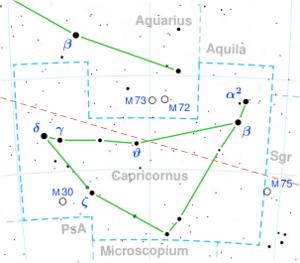Astronomy:LP 816-60
From HandWiki
Short description: Star in the constellation Capricornus
Coordinates: ![]() 20h 52m 33.01679s, −16° 58′ 29.0249″
20h 52m 33.01679s, −16° 58′ 29.0249″
| Observation data Equinox J2000.0]] (ICRS) | |
|---|---|
| Constellation | Capricornus |
| Right ascension | Template:Ra[1] |
| Declination | −16° 58′ 29.0249″[1] |
| Apparent magnitude (V) | 11.458[2] |
| Characteristics | |
| Spectral type | M4[3] |
| Astrometry | |
| Radial velocity (Rv) | 8.5[4] km/s |
| Proper motion (μ) | RA: -309.115[5] mas/yr Dec.: 37.051[5] mas/yr |
| Parallax (π) | 177.9312 ± 0.0365[5] mas |
| Distance | 18.330 ± 0.004 ly (5.620 ± 0.001 pc) |
| Details[6] | |
| Mass | 0.224±0.022 M☉ |
| Radius | 0.266±0.012 R☉ |
| Surface gravity (log g) | 4.584[7] cgs |
| Temperature | 3030±27[8] K |
| Metallicity [Fe/H] | -0.11±0.07[8] dex |
| Rotation | 67.6±0.1 d.[9] |
| Rotational velocity (v sin i) | 2.70±0.66[7] km/s |
| Age | 2.57+8.15−1.95 Gyr |
| Other designations | |
| Database references | |
| SIMBAD | data |
Location of LP 816-60 in the constellation Capricornus | |
LP 816-60 is a single[3] red dwarf star of spectral type M4, located in constellation Capricornus at 18.6 light-years from Earth.[1]
History of observations
The discovery name of this star is LP 816-60,[12] which indicates that its discovery was published between 1963 and 1981 in University of Minnesota, Minneapolis.[13]
LP 816-60 is known at least from 1979, when it was included to Luyten's catalogue NLTT.[10]
Physical properties
No massive planets were detected around LP 816-60 as in 2013.[3] The star has a magnetic starspot cycle of 10.6±1.7 years,[9] and weak magnetic fields in chromosphere averaging 4.4 G.[14]
References
- ↑ 1.0 1.1 1.2 1.3 Perryman (1997). "HIP 103039". The Hipparcos and Tycho Catalogues. http://webviz.u-strasbg.fr/viz-bin/VizieR-5?-source=I/239/hip_main&HIP=103039.
- ↑ Koen, C.; Kilkenny, D.; van Wyk, F.; Marang, F. (2010). "UBV(RI)C JHK observations of Hipparcos-selected nearby stars". Monthly Notices of the Royal Astronomical Society 403 (4): 1949–1968. doi:10.1111/j.1365-2966.2009.16182.x. Bibcode: 2010MNRAS.403.1949K.
- ↑ 3.0 3.1 3.2 Montet, Benjamin T.; Crepp, Justin R.; Johnson, John Asher; Howard, Andrew W.; Marcy, Geoffrey W. (2013), "The Trends High-Contrast Imaging Survey. Iv. The Occurrence Rate of Giant Planets Around M Dwarfs", The Astrophysical Journal 781: 28, doi:10.1088/0004-637X/781/1/28
- ↑ Henry, Todd J.; Jao, Wei-Chun; Winters, Jennifer G.; Dieterich, Sergio B.; Finch, Charlie T.; Ianna, Philip A.; Riedel, Adric R.; Silverstein, Michele L. et al. (2018), "The Solar Neighborhood XLIV: RECONS Discoveries within 10 parsecs", The Astronomical Journal 155 (6): 265, doi:10.3847/1538-3881/aac262, Bibcode: 2018AJ....155..265H
- ↑ 5.0 5.1 Brown, A. G. A. (2021). "Gaia Early Data Release 3: Summary of the contents and survey properties". Astronomy & Astrophysics 649: A1. doi:10.1051/0004-6361/202039657. Bibcode: 2021A&A...649A...1G. Gaia EDR3 record for this source at VizieR.
- ↑ Mann, Andrew W.; Feiden, Gregory A.; Gaidos, Eric; Boyajian, Tabetha; Braun, Kaspar von (2015), "How to Constrain Your M Dwarf: Measuring Effective Temperature, Bolometric Luminosity, Mass, and Radius", The Astrophysical Journal 804 (1): 64, doi:10.1088/0004-637X/804/1/64, Bibcode: 2015ApJ...804...64M
- ↑ 7.0 7.1 Hojjatpanah, S.; Figueira, P.; Santos, N. C.; Adibekyan, V.; Sousa, S. G.; Delgado-Mena, E.; Alibert, Y.; Cristiani, S. et al. (2019), "Catalog for the ESPRESSO blind radial velocity exoplanet survey", Astronomy & Astrophysics 629: A80, doi:10.1051/0004-6361/201834729, Bibcode: 2019A&A...629A..80H
- ↑ 9.0 9.1 Suárez Mascareño, A.; Rebolo, R.; González Hernández, J. I. (2016), "Magnetic cycles and rotation periods of late-type stars from photometric time series", Astronomy & Astrophysics 595: A12, doi:10.1051/0004-6361/201628586, Bibcode: 2016A&A...595A..12S
- ↑ 10.0 10.1 Luyten, Willem Jacob (1979). "NLTT 50038". NLTT Catalogue. http://webviz.u-strasbg.fr/viz-bin/VizieR-5?-source=I/98A&recno=50038.
- ↑ Perryman (1997). "HIP 103039". The Hipparcos and Tycho Catalogues. http://webviz.u-strasbg.fr/viz-bin/VizieR-5?-source=I/239/tyc_main&HIP=103039.
- ↑ Kirkpatrick, J. Davy; Gelino, Christopher R.; Cushing, Michael C.; Mace, Gregory N.; Griffith, Roger L.; Skrutskie, Michael F.; Marsh, Kenneth A.; Wright, Edward L. et al. (2012). "Further Defining Spectral Type "Y" and Exploring the Low-mass End of the Field Brown Dwarf Mass Function". The Astrophysical Journal 753 (2): 156. doi:10.1088/0004-637X/753/2/156. Bibcode: 2012ApJ...753..156K.
- ↑ Dictionary of Nomenclature of Celestial Objects. LP entry. SIMBAD. Centre de Données astronomiques de Strasbourg.
- ↑ Moutou, C.; Hébrard, E. M.; Morin, J.; Malo, L.; Fouqué, P.; Torres-Rivas, A.; Martioli, E.; Delfosse, X. et al. (2017), "SPIRou input catalogue: Activity, rotation and magnetic field of cool dwarfs", Monthly Notices of the Royal Astronomical Society 472 (4): 4563–4586, doi:10.1093/mnras/stx2306
 |


